I am trying to execute a simple code from RAM, but for some reason the program halts/throws hard fault. I am using CCMRAM for my data, heap and stack while SRAM1 for executing code. Here is my linker script and startup file.
LinkerScript.ld
/*
******************************************************************************
**
** File : LinkerScript.ld
**
** Author : Auto-generated by Ac6 System Workbench
**
** Abstract : Linker script for STM32F407ZETx Device from STM32F4 series
** 112Kbytes SRAM1
** 16Kbytes SRAM2
** 64Kbytes CCMRAM
** 512Kbytes ROM
**
** Set heap size, stack size and stack location according
** to application requirements.
**
** Set memory bank area and size if external memory is used.
**
** Target : STMicroelectronics STM32
**
** Distribution: The file is distributed �as is,� without any warranty
** of any kind.
**
*****************************************************************************
** @attention
**
** <h2><center>© COPYRIGHT(c) 2019 Ac6</center></h2>
**
** Redistribution and use in source and binary forms, with or without modification,
** are permitted provided that the following conditions are met:
** 1. Redistributions of source code must retain the above copyright notice,
** this list of conditions and the following disclaimer.
** 2. Redistributions in binary form must reproduce the above copyright notice,
** this list of conditions and the following disclaimer in the documentation
** and/or other materials provided with the distribution.
** 3. Neither the name of Ac6 nor the names of its contributors
** may be used to endorse or promote products derived from this software
** without specific prior written permission.
**
** THIS SOFTWARE IS PROVIDED BY THE COPYRIGHT HOLDERS AND CONTRIBUTORS "AS IS"
** AND ANY EXPRESS OR IMPLIED WARRANTIES, INCLUDING, BUT NOT LIMITED TO, THE
** IMPLIED WARRANTIES OF MERCHANTABILITY AND FITNESS FOR A PARTICULAR PURPOSE ARE
** DISCLAIMED. IN NO EVENT SHALL THE COPYRIGHT HOLDER OR CONTRIBUTORS BE LIABLE
** FOR ANY DIRECT, INDIRECT, INCIDENTAL, SPECIAL, EXEMPLARY, OR CONSEQUENTIAL
** DAMAGES (INCLUDING, BUT NOT LIMITED TO, PROCUREMENT OF SUBSTITUTE GOODS OR
** SERVICES; LOSS OF USE, DATA, OR PROFITS; OR BUSINESS INTERRUPTION) HOWEVER
** CAUSED AND ON ANY THEORY OF LIABILITY, WHETHER IN CONTRACT, STRICT LIABILITY,
** OR TORT (INCLUDING NEGLIGENCE OR OTHERWISE) ARISING IN ANY WAY OUT OF THE USE
** OF THIS SOFTWARE, EVEN IF ADVISED OF THE POSSIBILITY OF SUCH DAMAGE.
**
*****************************************************************************
*/
/* Entry Point */
ENTRY(Reset_Handler)
/* Highest address of the user mode stack */
/*_estack = 0x2001C000; /* start of SRAM2 */
_estack = 0x10010000; /* end of CCMRAM */
_Min_Heap_Size = 0; /* required amount of heap */
_Min_Stack_Size = 0x400; /* required amount of stack */
/* Memories definition */
MEMORY
{
SRAM1 (xrw) : ORIGIN = 0x20000000, LENGTH = 112K
SRAM2 (xrw) : ORIGIN = 0x2001C000, LENGTH = 16K
FLASH (rx) : ORIGIN = 0x08000000, LENGTH = 512K
CCMRAM (rw) : ORIGIN = 0x10000000, LENGTH = 64K
}
/* Sections */
SECTIONS
{
/* The startup code into ROM memory */
.isr_vector :
{
. = ALIGN(4);
KEEP(*(.isr_vector)) /* Startup code */
. = ALIGN(4);
} >FLASH
/*sram1 section for code and data*/
_sisram1 = LOADADDR(.sram1);
.sram1 :
{
. = ALIGN(4);
_s_sram1 = .;
*(.sram1);
*(.sram1*);
. = ALIGN(4);
_e_sram1 = .;
} > SRAM1 AT >FLASH
/*sram2 section for code and data*/
_sisram2 = LOADADDR(.sram2);
.sram2 :
{
. = ALIGN(4);
_s_sram2 = .;
*(.sram2);
*(.sram2*);
. = ALIGN(4);
_e_sram2 = .;
} > SRAM2 AT >FLASH
/* The program code and other data into FLASH memory */
.text :
{
. = ALIGN(4);
*(.text) /* .text sections (code) */
*(.text*) /* .text* sections (code) */
*(.glue_7) /* glue arm to thumb code */
*(.glue_7t) /* glue thumb to arm code */
*(.eh_frame)
KEEP (*(.init))
KEEP (*(.fini))
. = ALIGN(4);
_etext = .; /* define a global symbols at end of code */
} >FLASH
/* Constant data into FLASH memory*/
.rodata :
{
. = ALIGN(4);
*(.rodata) /* .rodata sections (constants, strings, etc.) */
*(.rodata*) /* .rodata* sections (constants, strings, etc.) */
. = ALIGN(4);
} >FLASH
.ARM.extab : {
. = ALIGN(4);
*(.ARM.extab* .gnu.linkonce.armextab.*)
. = ALIGN(4);
} > FLASH
.ARM : {
. = ALIGN(4);
__exidx_start = .;
*(.ARM.exidx*)
__exidx_end = .;
. = ALIGN(4);
} >FLASH
.preinit_array :
{
. = ALIGN(4);
PROVIDE_HIDDEN (__preinit_array_start = .);
KEEP (*(.preinit_array*))
PROVIDE_HIDDEN (__preinit_array_end = .);
. = ALIGN(4);
} >FLASH
.init_array :
{
. = ALIGN(4);
PROVIDE_HIDDEN (__init_array_start = .);
KEEP (*(SORT(.init_array.*)))
KEEP (*(.init_array*))
PROVIDE_HIDDEN (__init_array_end = .);
. = ALIGN(4);
} >FLASH
.fini_array :
{
. = ALIGN(4);
PROVIDE_HIDDEN (__fini_array_start = .);
KEEP (*(SORT(.fini_array.*)))
KEEP (*(.fini_array*))
PROVIDE_HIDDEN (__fini_array_end = .);
. = ALIGN(4);
} >FLASH
/* Used by the startup to initialize data */
_sidata = LOADADDR(.data);
/* Initialized data sections into RAM memory */
.data :
{
. = ALIGN(4);
_sdata = .; /* create a global symbol at data start */
*(.data) /* .data sections */
*(.data*) /* .data* sections */
. = ALIGN(4);
_edata = .; /* define a global symbol at data end */
} >CCMRAM AT> FLASH
/* Uninitialized data section into RAM memory */
. = ALIGN(4);
.bss :
{
/* This is used by the startup in order to initialize the .bss secion */
_sbss = .; /* define a global symbol at bss start */
__bss_start__ = _sbss;
*(.bss)
*(.bss*)
*(COMMON)
. = ALIGN(4);
_ebss = .; /* define a global symbol at bss end */
__bss_end__ = _ebss;
} >CCMRAM
/* User_heap_stack section, used to check that there is enough RAM left */
._user_heap_stack :
{
. = ALIGN(8);
PROVIDE ( end = . );
PROVIDE ( _end = . );
. = . + _Min_Heap_Size;
. = . + _Min_Stack_Size;
. = ALIGN(8);
} >CCMRAM
/* Remove information from the compiler libraries */
/DISCARD/ :
{
libc.a ( * )
libm.a ( * )
libgcc.a ( * )
}
.ARM.attributes 0 : { *(.ARM.attributes) }
}
And here is part of my startup file
/**
******************************************************************************
* @file startup_stm32.s dedicated to STM32F407ZETx device
* @author Ac6
* @version V1.0.0
* @date 2019-03-30
******************************************************************************
*/
.syntax unified
.cpu cortex-m4
.fpu softvfp
.thumb
.global g_pfnVectors
.global Default_Handler
/* start address for the initialization values of the .data section.
defined in linker script */
.word _sidata
/* start address for the .data section. defined in linker script */
.word _sdata
/* end address for the .data section. defined in linker script */
.word _edata
/* start address for the .bss section. defined in linker script */
.word _sbss
/* end address for the .bss section. defined in linker script */
.word _ebss
/**
* @brief This is the code that gets called when the processor first
* starts execution following a reset event. Only the absolutely
* necessary set is performed, after which the application
* supplied main() routine is called.
* @param None
* @retval : None
*/
.section .text.Reset_Handler
.weak Reset_Handler
.type Reset_Handler, %function
Reset_Handler:
ldr r0, =_estack
mov sp, r0 /* set stack pointer */
/* Copy the data segment initializers from flash to SRAM */
ldr r0, =_sdata
ldr r1, =_edata
ldr r2, =_sidata
movs r3, #0
b LoopCopyDataInit
CopyDataInit:
ldr r4, [r2, r3]
str r4, [r0, r3]
adds r3, r3, #4
LoopCopyDataInit:
adds r4, r0, r3
cmp r4, r1
bcc CopyDataInit
/* Zero fill the bss segment. */
ldr r2, =_sbss
ldr r4, =_ebss
movs r3, #0
b LoopFillZerobss
FillZerobss:
str r3, [r2]
adds r2, r2, #4
LoopFillZerobss:
cmp r2, r4
bcc FillZerobss
///////////// Following blocks are for SRAM1 /////////////////////
// Copy from flash to SRAM1
ldr r0, =_s_sram1
ldr r1, =_e_sram1
ldr r2, =_sisram1
movs r3, #0
b LoopCopySRAM1Init
CopySRAM1Init:
ldr r4, [r2, r3]
str r4, [r0, r3]
adds r3, r3, #4
LoopCopySRAM1Init:
adds r4, r0, r3
cmp r4, r1
bcc CopySRAM1Init
// End of data copy from Flash to SRAM1
// Zero fill the SRAM1 segment.
ldr r2, =_s_sram1
b LoopFillZeroSRAM1
FillZeroSRAM1:
movs r3, #0
str r3, [r2]
adds r2, r2, #4
LoopFillZeroSRAM1:
ldr r3, = _e_sram1
cmp r2, r3
bcc FillZeroSRAM1
//////////////// End of SRAM1 Blocks /////////////////
///////////// Following blocks are for SRAM2 /////////////////////
// Copy from flash to SRAM2
ldr r0, =_s_sram2
ldr r1, =_e_sram2
ldr r2, =_sisram2
movs r3, #0
b LoopCopySRAM2Init
CopySRAM2Init:
ldr r4, [r2, r3]
str r4, [r0, r3]
adds r3, r3, #4
LoopCopySRAM2Init:
adds r4, r0, r3
cmp r4, r1
bcc CopySRAM2Init
// End of data copy from Flash to SRAM2
// Zero fill the SRAM2 segment.
ldr r2, =_s_sram2
b LoopFillZeroSRAM2
FillZeroSRAM2:
movs r3, #0
str r3, [r2]
adds r2, r2, #4
LoopFillZeroSRAM2:
ldr r3, = _e_sram2
cmp r2, r3
bcc FillZeroSRAM2
//////////////// End of SRAM2 Blocks /////////////////
/* Call the clock system intitialization function.*/
bl SystemInit
/* Call static constructors */
bl __libc_init_array
/* Call the application's entry point.*/
bl main
LoopForever:
b LoopForever
Can anybody please help me if there is any bug here. Lets say, for now we are only trying to run code from SRAM1 since that is the one which is connected to I-bus and D-bus ports of the Cortex M4 on this MCU. With respect to the picture below, I would expect bl to be jumping to beginning of SRAM1.. Can you please shed some light on it:





